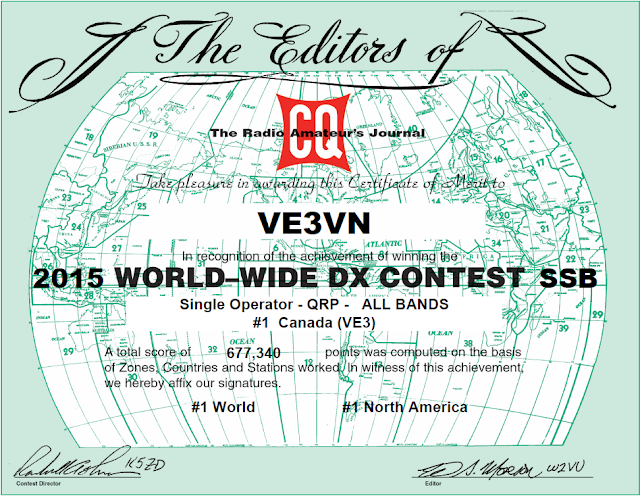With the recent release of the 2015 CQWW SSB official scores I can now confirm that I have, for the second year in a row, won #1 QRP SOAB (single-op all-band, unassisted). This makes me King of the Munchkins. Or something like that.
QRP gets little respect among the majority of serious contesters. Reasons I've heard range from "life's too short
for QRP" to
"all that effort for such a small score?" For most, bigger equates to better. The pinnacle is always considered to be high power with a large antenna
farm where you pit your skills against the elite ranks for
the highest score in the world or continent. That and a good location, preferably tropical and a desirable multiplier. No matter your antennas or power, competing from VE3 is limited by propagation and prefix.
Ranking first in a QRP category is beneath the attention of most contesters is a mixed blessing. We're the short guys always getting underfoot, difficult to copy and get into the log, and contribute little to club scores. That's a shame since QRP exercises skills that often go underutilized
when using higher power.
Some contesters with lots of experience and big stations try QRP and are seriously tried in getting a respectable score. The techniques required are quite different than when running higher power. You might expect that a big antenna farm will compensate, but that is only true to a point. There are 23 db between 5 watts and 1,000 watts. As impressive as those long boom yagis at dizzying heights might appear it will rarely make up the deficit.
From 807 to 4CX1500B
I see both sides. Until 2013 I had never operated QRP. The closest I came was an 807 transmitter in 1972 (my first rig) that may have put out 40 or more watts at times. I had no wattmeter so I am only guessing. Since then, as money and circumstances allowed, I strove to build bigger and higher antennas and run more and more power.
This trend culminated from 1985 to 1992 when I ran a small stack at 20+ meters height and a 40 meter wire yagi all powered by a Collins 30S-1. That is still modest but very good for a suburban lot. From 1980 to 1990 I also did multi-op contests from other stations, usually those with larger antenna farms.
When I went QRT in 1992 the 30S-1 (and everything else I didn't sell or give away) went into storage. The 30S-1 was sold about a decade later when a persistent Collins collector caught me at a weak moment.
Less than it seems
My claim to the Munchkin kingship is perhaps not as secure as I first claimed. Category ranking often has more to do with the vagaries of location and scoring. There are QRP contesters in the US northeast with bigger antennas and no less skill. Yet in CQWW I often outscore them. I cannot do so in the ARRL DX contests where the availability of QSO points between US and Canadian entrants is more equitable.
On the other side of the Atlantic the European QRP contesters are handicapped in CQWW by scoring 1 point for inter-country European QSOs while I get 2 points per US QSO. This rule might be overcompensation for their rich mine of nearby multipliers and daylight low-band QSOs.
All that said it is still pleasant to receive some recognition for doing my best with 5 watts and a modest antenna farm. My global ranking in CQWW CW is likely to rise this year because of fewer QRP operations from attractive multiplier locales. If the claimed scores hold I will place second behind GJ2A. We'll know for sure in a few weeks.
As far as all-time records, I only have one, and that is for Canada. I cannot compete with the solar cycle or the occasional QRP operation from a station with a large antenna farm. I hold the QRP SSB rate record for Canada, but in CW the record is held by VE6EX. There are many records from solar cycle 23 that could not be touched cycle 24.
QRO to QRP and back again
I've pretty much had my fill of QRP contesting. Looking forward I will be in the low power (100 watts) category in most contests for the next while. With the prospect of building a new station with a large antenna farm I expect to gravitate back to "bigger is better", but in stages rather than all at once.
While it's been fun operating QRP it is not a lifelong attachment. I expect the number of high contest rankings I've achieved to drop drastically even with bigger antennas. I have no illusions about my abilities when compared to the best in the world. Even so I expect to have a lot of fun, including more QSOs in the log. For me it's more about the fun and the station building, not mererly the score.
Although the 30S-1 is long gone I don't really miss it since it was not a good amplifier for contesting. Tuning was a nervous procedure due to the fragility of the power tetrode. Even with the plug compatible and more robust 4CX1500B in place rather than the original 4CX1000A it was not fun. Careful tuning was mandatory for every large frequency excursion, band change and antenna change. A simple error is all it takes to fry a grid with a power dissipation rating of 0 watts! It wasn't even all that great for DXing because of the 3 minute warm up it required.
My next kilowatt amplifier will most likely be no-tune solid state or use a grounded-grid triode. With the latter you can at least use dial markings to speed band changes and not panic over small mistakes.

No comments:
Post a Comment
All comments are moderated, and should appear within one day of submission.